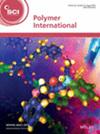求助PDF
{"title":"Thermal behavior of polymers and copolymers based on plant oils with differing saturated and monounsaturated content","authors":"Anastasiia Chebotar, Bohdan Domnich, Yurij Panchenko, Volodymyr Donchak, Yurij Stetsyshyn, Andriy Voronov","doi":"10.1002/pi.6717","DOIUrl":null,"url":null,"abstract":"<p>Plant oil-based acrylic monomers from hydrogenated sunflower (HFM), palm (PMM) and castor (CSM) oils were polymerized to investigate the effect of chemical composition on polymer phase transitions at temperatures relevant to physiological range. While HFM and PMM possess a highly differing content of saturated palmitic and stearic acids combined with unsaturated fatty acids, CSM contains primarily fragments based on monounsaturated ricinoleic hydroxy acid (up to 90%). Differential scanning calorimetry (DSC) measurements indicate that polymers from PMM and HFM are both semicrystalline (with <i>T</i><sub>m</sub> = −6 and −13 °C, respectively), while poly(CSM) appears to be amorphous (<i>T</i><sub>g</sub> = −49 °C). Considering the similarity in polymers' molar mass (<i>M</i><sub>n</sub> = 16 000–20 000 g mol<sup>−1</sup>), the observed thermal transitions can be explained by the formation of ordered morphological domains due to the presence of saturated palmitic and stearic acid fractions in poly(PMM) and poly(HFM). For copolymers of CSM, PMM and HFM (80 wt% of monomer feed) with styrene, DSC data show two transitions corresponding to the mobility of long alkyl fatty acid side fragments and the macromolecular backbone. For copolymers of PMM and HFM, comparable values (−52.8 and −55.5 °C, respectively) were obtained, while the second transition for poly(CSM-<i>co</i>-styrene) appears at 35 °C. We attribute this higher value to the presence of hydroxyl groups in ricinoleic acid fragments of CSM serving as additional chain transfer sites and the formation of macromolecular fractions enriched with polystyrene fragments. We expect that the temperature transitions obtained can be relevant to the future use of these polymers for biomedical applications, including the synthesis of polymer brushes. © 2024 Society of Chemical Industry.</p>","PeriodicalId":20404,"journal":{"name":"Polymer International","volume":"74 3","pages":"255-263"},"PeriodicalIF":2.9000,"publicationDate":"2024-11-14","publicationTypes":"Journal Article","fieldsOfStudy":null,"isOpenAccess":false,"openAccessPdf":"","citationCount":"0","resultStr":null,"platform":"Semanticscholar","paperid":null,"PeriodicalName":"Polymer International","FirstCategoryId":"92","ListUrlMain":"https://onlinelibrary.wiley.com/doi/10.1002/pi.6717","RegionNum":4,"RegionCategory":"化学","ArticlePicture":[],"TitleCN":null,"AbstractTextCN":null,"PMCID":null,"EPubDate":"","PubModel":"","JCR":"Q2","JCRName":"POLYMER SCIENCE","Score":null,"Total":0}
引用次数: 0
引用
批量引用
Abstract
Plant oil-based acrylic monomers from hydrogenated sunflower (HFM), palm (PMM) and castor (CSM) oils were polymerized to investigate the effect of chemical composition on polymer phase transitions at temperatures relevant to physiological range. While HFM and PMM possess a highly differing content of saturated palmitic and stearic acids combined with unsaturated fatty acids, CSM contains primarily fragments based on monounsaturated ricinoleic hydroxy acid (up to 90%). Differential scanning calorimetry (DSC) measurements indicate that polymers from PMM and HFM are both semicrystalline (with T m = −6 and −13 °C, respectively), while poly(CSM) appears to be amorphous (T g = −49 °C). Considering the similarity in polymers' molar mass (M n = 16 000–20 000 g mol−1 ), the observed thermal transitions can be explained by the formation of ordered morphological domains due to the presence of saturated palmitic and stearic acid fractions in poly(PMM) and poly(HFM). For copolymers of CSM, PMM and HFM (80 wt% of monomer feed) with styrene, DSC data show two transitions corresponding to the mobility of long alkyl fatty acid side fragments and the macromolecular backbone. For copolymers of PMM and HFM, comparable values (−52.8 and −55.5 °C, respectively) were obtained, while the second transition for poly(CSM-co -styrene) appears at 35 °C. We attribute this higher value to the presence of hydroxyl groups in ricinoleic acid fragments of CSM serving as additional chain transfer sites and the formation of macromolecular fractions enriched with polystyrene fragments. We expect that the temperature transitions obtained can be relevant to the future use of these polymers for biomedical applications, including the synthesis of polymer brushes. © 2024 Society of Chemical Industry.


